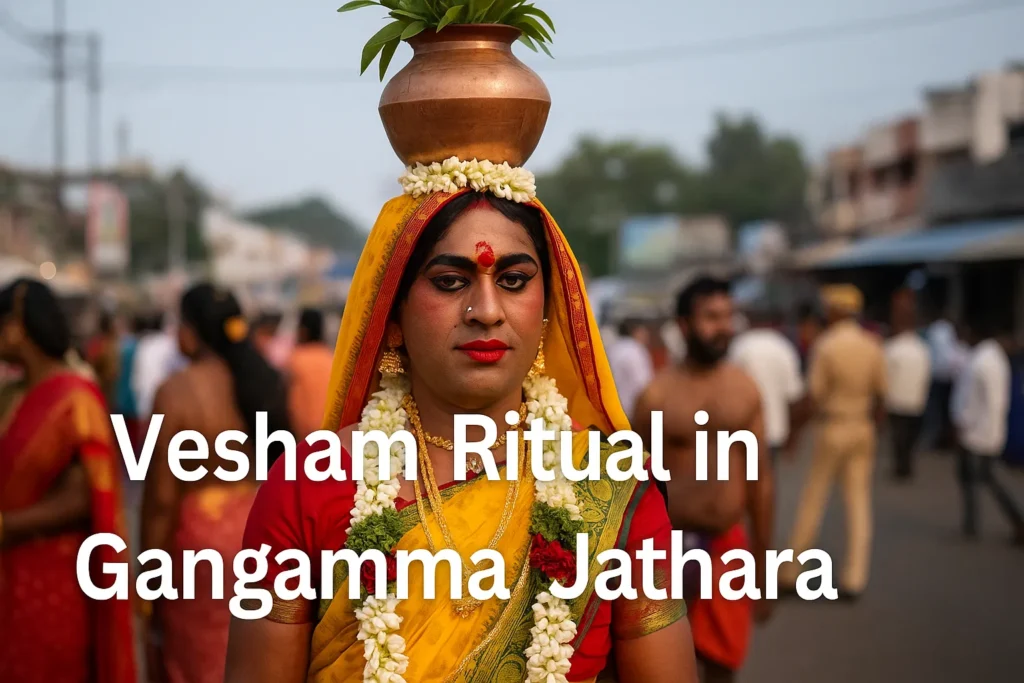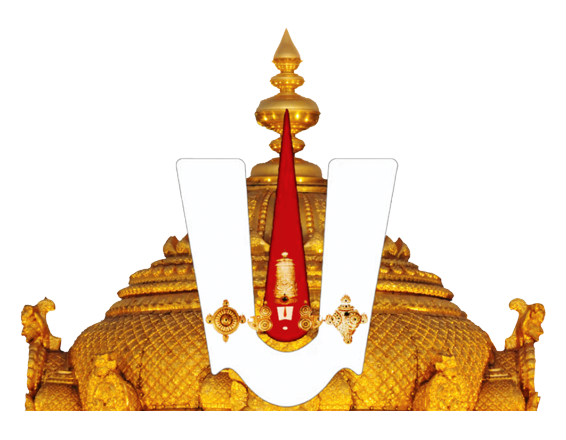Discover the sacred Vesham ritual in Gangamma Jathara, where male devotees dress as women to honor the goddess. Explore the history, spiritual significance, and types of this unique South Indian tradition that transcends conventional gender roles through divine embodiment and devotion.
The Vesham ritual in Gangamma Jathara represents one of the most fascinating cultural practices in South Indian folk traditions. As someone who has documented religious festivals across Andhra Pradesh for over a decade, I’ve been privileged to witness this unique aspect of the Gangamma Jathara firsthand. This ancient practice, where male devotees adorn themselves in female attire to honor the powerful goddess Gangamma, offers profound insights into the fluid concepts of gender in Hindu religious expressions and the complex tapestry of folk traditions that continue to thrive in modern India.

Table of Contents
The Historical Origins of Vesham Ritual in Gangamma Jathara
The Vesham ritual in Gangamma Jathara traces its origins to the medieval period, though oral traditions suggest even older roots. Gangamma, a fierce form of the divine feminine known as Shakti, is believed to be the guardian deity of Tirupati. According to local legend, she manifested to protect the region from a demon named Bakasura who terrorized the populace.
Historical records indicate that the practice gained significant prominence during the Vijayanagara Empire (14th-17th centuries), when temple traditions were formalized across South India. The Archaeological Survey of India has documented inscriptions from this period that make references to ritual practices honoring Gangamma, though specific mentions of the Vesham ritual appear in later texts.
The historical context of the Vesham ritual in Gangamma Jathara is crucial to understanding its significance. Unlike many temple practices that originated from Brahmanical traditions, the Gangamma worship and associated rituals emerged from folk traditions, representing the religious expressions of communities often marginalized in mainstream Hinduism. This grassroots origin has contributed to the ritual’s unique characteristics and continued relevance.
Types of Vesham in Gangamma Jathara
The Vesham ritual in Gangamma Jathara is not a monolithic practice but encompasses several distinct variations, each with specific significance and performed on designated days during the week-long festival. Having documented these variations over multiple years, I’ve observed the meticulous attention to detail that goes into each type:
Bhairagi Vesham
Bhairagi Vesham, performed on the fourth day of the Gangamma Jathara, is perhaps the most visually striking of all Vesham types. In this ritual, male devotees dress as female ascetics or yoginis, representing the fierce, ascetic aspect of the goddess. The attire typically includes:
- White or saffron saris, symbolizing renunciation
- Rudraksha beads and simple ornaments
- Ash markings on the forehead and body
- Disheveled hair or simple head coverings
The participants often carry tridents (trishul) or other emblems associated with Shakti worship. During my documentation of the 2018 Gangamma Jathara, I interviewed several Bhairagi Vesham participants who described feeling a profound connection to the goddess’s austere power during the ritual.
Pattu Vesham
Contrasting with the ascetic Bhairagi Vesham, Pattu Vesham (performed on the fifth day) represents the goddess in her magnificent, royal aspect. “Pattu” refers to silk, and this Vesham is characterized by:
- Expensive silk saris in bright colors, particularly red and gold
- Elaborate jewelry, including temple jewelry designs
- Complete bridal makeup with traditional motifs
- Flowers arranged in traditional South Indian hairstyles
The Pattu Vesham participants process through the streets of Tirupati in a grand display, receiving offerings from devotees along the route. The Anthropological Survey of India has documented how this ritual represents the goddess’s sovereignty over the region, with the male devotees embodying her royal authority.
Mandapam Vesham
The sixth day of Gangamma Jathara features Mandapam Vesham, which focuses on mythological storytelling through embodiment. In this variation, devotees enact various forms of the goddess and other divine figures from Hindu mythology. The costumes vary widely depending on the specific deity or character being portrayed.
What makes Mandapam Vesham particularly interesting is its theatrical element. Participants not only dress in female attire but also perform episodes from the Gangamma mythology, especially her victory over Bakasura. According to tradition, these performances are believed to reinvigorate the protective energy of the goddess over Tirupati.
The Theological Significance of Cross-Dressing in Hindu Worship
The Vesham ritual in Gangamma Jathara raises fascinating theological questions about gender in Hindu worship traditions. To understand its significance fully, we must examine it within the broader context of gender fluidity in Hindu religious expression.
Divine Gender Fluidity in Hindu Traditions
Hindu theology has long embraced concepts of gender fluidity in divine manifestations. Deities like Ardhanarishvara (half Shiva, half Parvati) explicitly represent the integration of masculine and feminine principles. The concept of “Prakruti” (feminine creative energy) and “Purusha” (masculine consciousness) as complementary rather than oppositional forces underlies much of Hindu philosophy.
According to Dr. Annapurna Garimella, an art historian specializing in South Indian temple traditions, “The Vesham ritual in Gangamma Jathara challenges our contemporary binary understanding of gender by demonstrating that in the context of devotion, the physical body can be transcended to embody divine energy regardless of gender.” Her research papers on this topic provide valuable scholarly insights into the theological frameworks supporting such practices.
Embodiment as Devotional Practice
The concept of embodiment is central to understanding the Vesham ritual in Gangamma Jathara. Unlike symbolic representations through idols or images, the devotee literally becomes a vessel for the divine feminine energy through physical transformation. This practice aligns with the Hindu concept of “sadhana” (spiritual practice) through bodily discipline and transformation.
What makes this particularly significant is that male devotees embody the feminine divine not to express personal gender identity but as an act of surrender and devotion. During my interviews with participants, many described feeling a temporary dissolution of their male identity during the ritual, experiencing instead a profound connection to the goddess’s energy.
The Process of Preparation for Vesham
The Vesham ritual in Gangamma Jathara involves elaborate preparation that begins days before the actual performance. Having been permitted to document these preparations in 2019, I observed a process that combines religious devotion with artistic expression:
Physical and Spiritual Purification
Devotees undertaking Vesham observe specific purification rituals in the days leading up to their performance:
- Abstaining from meat, alcohol, and sexual activity
- Taking ritual baths with turmeric and neem
- Performing specific prayers to Gangamma
- Fasting partially or completely on the day before their Vesham
One participant, a 52-year-old businessman who has performed Bhairagi Vesham for over twenty years, explained that this purification is essential: “The goddess cannot enter an impure vessel. Our bodies must be purified to receive her energy.”
The Transformation Process
The physical transformation begins early on the day of the Vesham, often starting at around 3 or 4 AM and taking several hours to complete. Traditional artists specializing in Vesham makeup, known locally as “Vesham mettuvallu,” assist in this transformation. The process typically includes:
- Application of a base layer of makeup to lighten and smooth the skin
- Elaborate eye makeup with extended lines representing the goddess’s piercing gaze
- Application of traditional South Indian bridal makeup, including the distinctive red dot (bindi)
- Dressing in the appropriate sari and pleating it in the traditional South Indian style
- Adding jewelry appropriate to the specific type of Vesham being performed
- Styling the hair or attaching appropriate wigs with floral decorations
What struck me during my observation was the reverent atmosphere during this transformation. Despite the seemingly theatrical nature of the process, it is conducted with religious solemnity, with prayers and mantras recited throughout.
Community Participation and Social Dimensions
The Vesham ritual in Gangamma Jathara involves broad community participation, crossing boundaries of caste and class that might otherwise be rigidly observed in daily life.
Who Performs Vesham?
Traditionally, the right to perform certain Veshams was inherited within specific families or community groups. However, in contemporary practice, participation has become more democratic, with devotees from various backgrounds taking part based on personal vows (mokkubadi) made to the goddess.
During my research, I encountered Vesham participants from diverse occupational backgrounds:
- Government employees
- Business owners
- Agricultural workers
- Professional artists
- Students and academics
A common thread among participants was a personal or family connection to Gangamma, often related to fulfilling vows made during times of crisis or illness. Many had been performing the Vesham ritual in Gangamma Jathara annually for decades.
Reception and Recognition
The reception of Vesham participants by the community is notable for its reverence. Rather than being viewed through the lens of contemporary gender politics, participants are seen as embodiments of the divine feminine. During the processions, devotees offer prayers, gifts, and food to the Vesham performers, treating them as living manifestations of the goddess herself.
The Ministry of Culture, Government of India has recognized the Vesham ritual in Gangamma Jathara as an important intangible cultural heritage, acknowledging its significance in India’s diverse religious landscape. This recognition has helped preserve the practice while bringing it to wider attention.
Vesham Ritual in Gangamma Jathara and Similar Practices Across India
The Vesham ritual in Gangamma Jathara, while distinctive, is not entirely unique in Indian religious traditions. Cross-gender performances as devotional practices appear in various regional festivals across the country.
Koothandavar Festival in Tamil Nadu
In Tamil Nadu, the Koothandavar Festival features men dressing as brides to reenact the story of Aravan from the Mahabharata. This 18-day festival culminates in hundreds of men dressing as brides to commemorate Aravan’s last wish to experience marriage before his sacrifice.
Chamayavilakku in Kerala
The Chamayavilakku ritual in certain temples of Kerala involves male devotees dressing as women to honor the goddess. Similar to the Vesham ritual in Gangamma Jathara, this practice is considered an expression of devotion rather than a statement about gender identity.
Linkages to Tirupati’s Religious Landscape
What makes the Vesham ritual in Gangamma Jathara particularly interesting is its coexistence with the more orthodox traditions of the nearby Venkateswara Temple at Tirumala, one of the most important pilgrimage sites in Hinduism. The contrast between the highly formalized, Brahmanical rituals at Tirumala and the folk traditions of Gangamma worship including Vesham showcases the remarkable diversity within Hindu practice even within a single geographic region.
Evolution and Adaptation of the Tradition
The Vesham ritual in Gangamma Jathara, like all living traditions, has evolved over time, adapting to changing social conditions while preserving its essential spiritual significance.
Historical Adaptations
Historical accounts suggest that the Vesham ritual became more elaborate during the colonial period, possibly as an assertion of cultural identity in the face of European influence. The post-independence period saw further formalization of the festival, with government recognition bringing additional resources and visibility.
Contemporary Challenges and Adaptations
In the contemporary context, the Vesham ritual in Gangamma Jathara faces several challenges:
- Media representation: The increasing presence of media at the festival has changed the performance context, sometimes emphasizing visual spectacle over spiritual significance
- Tourism: Growing tourism interest has introduced audiences unfamiliar with the ritual’s religious context
- Religious reform movements: Some Hindu reform movements have questioned folk practices like Vesham as “superstitious”
- Contemporary gender politics: The ritual occasionally faces misinterpretation through contemporary Western frameworks of gender and sexuality
Despite these challenges, the tradition has shown remarkable resilience. Organizers and participants have adapted by providing educational materials explaining the religious significance of the practice and emphasizing its cultural and spiritual foundations.
The Scholarly Study of Vesham Ritual in Gangamma Jathara
Academic interest in the Vesham ritual has grown significantly in recent decades, with scholars from various disciplines offering insights into its cultural significance.
Anthropological Perspectives
Anthropologists studying the Vesham ritual in Gangamma Jathara have emphasized its role in community cohesion and identity formation. Dr. Ramaswamy Tiwari of the University of Hyderabad has documented how the ritual creates temporary “sacred time” during which everyday social hierarchies are suspended, allowing for community renewal.
Gender Studies Approaches
Scholars working in gender studies have examined the Vesham ritual in Gangamma Jathara as an example of ritualized gender performance. Dr. Meena Radhakrishnan’s influential paper “Beyond Binary: Ritual Gender Performance in South Indian Goddess Worship” explores how the practice demonstrates the performance aspect of gender identity within specific cultural and religious contexts.
Art Historical Analysis
Art historians have analyzed the aesthetic elements of Vesham, particularly the makeup traditions and costume designs. These analyses reveal connections to classical dance forms like Bharatanatyam and Kuchipudi, suggesting cross-fertilization between folk and classical traditions in South Indian cultural expressions.
Experiencing the Vesham Ritual: A Personal Account
Having documented the Vesham ritual in Gangamma Jathara over several years, I’ve developed a deep appreciation for its complexity and beauty. During the 2017 festival, I was particularly moved by the transformation of a senior bank manager into a Pattu Vesham participant.
The man, in his early fifties, had performed this ritual annually for over two decades following his daughter’s recovery from a serious illness. Watching his transformation from a conservative, soft-spoken professional into a radiant embodiment of the goddess was extraordinary. The reverence with which he approached every aspect of the ritual—from the careful application of makeup to the deliberate, graceful movements during the procession—spoke to the depth of devotion underlying the practice.
What struck me most was the temporary but complete nature of his transformation. For those hours, he appeared to genuinely embody the goddess’s energy, his usual self-consciousness replaced by a serene confidence that captivated onlookers. When I spoke with him the following day, he described the experience as “being filled with her presence” and expressed that this annual ritual was the most profound spiritual experience of his life.
Practical Information for Witnessing the Vesham Ritual
For those interested in witnessing the Vesham ritual in Gangamma Jathara firsthand, here are some practical considerations based on my experiences documenting the festival:
Timing and Location
The Vesham rituals take place on specific days during the Gangamma Jathara, which is typically held in May each year (dates vary according to the lunar calendar). The festival centers around the Gangamma Temple in Tatayyagunta area of Tirupati, though processions move through various parts of the city.
Etiquette for Observers
If you plan to observe or photograph the Vesham ritual in Gangamma Jathara, keep these guidelines in mind:
- Approach with respect, recognizing the religious significance of the practice
- Ask permission before photographing participants
- Dress modestly, as befits a religious occasion
- Maintain appropriate distance during rituals and processions
- Consider making a small donation to the temple or to participants if you photograph them
Photography Considerations
The visual richness of the Vesham ritual makes it appealing for photographers, but sensitivity is essential:
- Early morning and evening processions offer the best light
- Avoid using flash during religious rituals
- Focus on capturing the devotional aspects rather than treating participants as exotic curiosities
- If publishing images, provide proper context explaining the religious significance
The Enduring Significance of the Vesham Ritual
The Vesham ritual in Gangamma Jathara stands as a powerful testament to the diversity and complexity of Hindu devotional practices. Far from being a mere cultural curiosity, it represents a sophisticated theological expression of divine embodiment that challenges simplified understandings of gender in religious contexts.
What makes this tradition particularly valuable is its grassroots nature—emerging from folk practices rather than institutional religion, it represents the lived spirituality of communities that have preserved their distinctive religious expressions despite centuries of social change. As a living tradition, it continues to evolve while maintaining its core spiritual significance.
For observers from different cultural backgrounds, the Vesham ritual in Gangamma Jathara offers an opportunity to move beyond simplified notions of gender and religious expression, inviting deeper understanding of how devotion can transcend physical limitations through ritual transformation. In a world increasingly dominated by homogenized cultural expressions, such distinctive traditions deserve not just preservation but thoughtful engagement and appreciation.
The male devotees who transform themselves through the Vesham ritual in Gangamma Jathara are not performing gender in the contemporary sense but are participating in an ancient practice of divine embodiment that transcends ordinary categories. Their transformation reminds us that in the realm of devotion, the boundaries we often take for granted can dissolve in the face of profound spiritual experience.
Author:
Prof. Anitha Ranga is an art historian with a deep appreciation for South Indian temple architecture. Her work highlights the intricate carvings, sculptures, and heritage of the Tirumala temple. With 25 years of academic experience, she brings a scholarly yet accessible perspective to her articles, enriching readers’ understanding of the temple’s artistic grandeur.
Email: [email protected]

